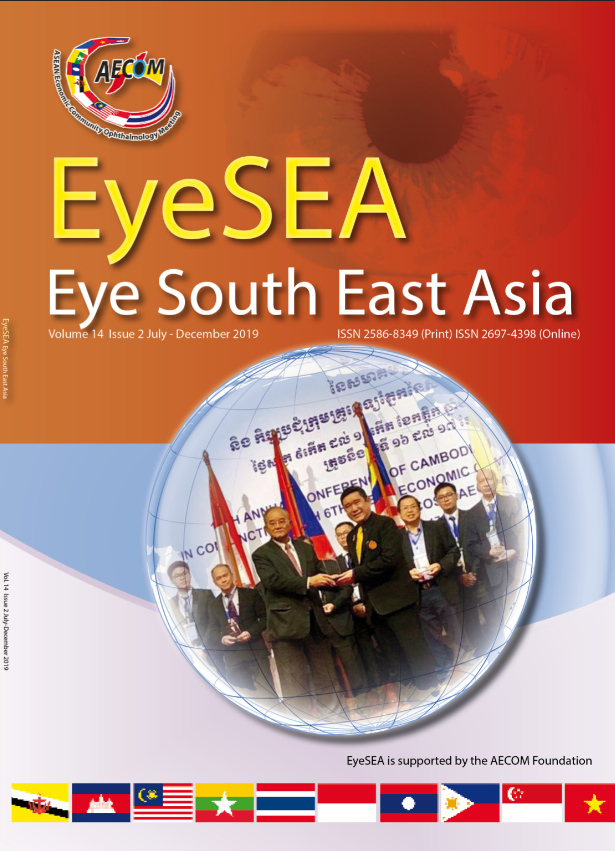The association between contact lens wear and the meibomian gland dysfunction in metropolis Bangkok
Main Article Content
Abstract
Purpose: To determine the prevalence of Meibomian gland dysfunction (MGD) in contact lens wearers and the effect of different modalities of contact lens (CL) on parameters related to MGD in Thai population.
Study design: Cross-sectional study.
Methods: 75 contact lens wearer subjects (ages 20-50 years old). The subjects’ health history and symptoms were assessed using questionnaire. The assessment of MGD and dry eye symptoms was conducted by a self-reported ocular symptom using ocular surface disease index (OSDI).
Results: There was a significant association between the severity of MGD and artificial tear used, participants who used artificial tear have less severity of MGD 1.36 compare to non-used group 1.63 (P = 0.01). It was found that severity of MGD had a significant correlation with color of CL (P = 0.023). The tinted and big eye CL seemed to produce higher degree of MGD comparing to clear CL, suggesting that CL material was significantly related to severity of MGD. Short time of CL wear per day seems to have lower severity of MGD.
Conclusion: MGD was found to be common in Thai contact lens wearers’ subjects, up to 74.7 %. The severity of MGD had significant correlation with color of CL used.
Keywords:
contact lens wear, meibomian gland dysfunction, ocular surface disease index, metropolis Bangkok
Article Details
References
1. Holly FJ. Tear film physiology. Am J Optom Physiol Opt. 1980;57:252-7.
2. Schaumberg DA, Nichols JJ, Papas EB, Tong L, Uchino M, Nichols KK. The International Workshop on Meibomian Gland Dysfunction: Report of the Subcommittee on the Epidemiology of, and Associated Risk Factors for, MGD. Investigative Ophthalmology & Visual Science. 2011;52:1994-2005. doi:10.1167/iovs.10-6997e.
3. Lemp MA. Report of the National Eye Institute/Industry workshop on Clinical Trials in Dry Eyes. CLAO J. 1995;21:221-32.
4. Shimazaki J, Sakata M, Tsubota K. Ocular surface changes and discomfort in patients with meibomian gland dysfunction. Archives of Ophthalmology. 1995;113:1266-70. doi:10.1001/archopht.1995.01100100054027.
5. Mathers WD. Ocular evaporation in meibomian gland dysfunction and dry eye. Ophthalmology. 1993;100:347-51.
6. Tomlinson A, Bron AJ, Korb DR, Amano S, Paugh JR, Pearce EI et al. The International Workshop on Meibomian Gland Dysfunction: Report of the Diagnosis Subcommittee. Investigative Ophthalmology & Visual Science. 2011;52:2006-49. doi:10.1167/iovs.10-6997f.
7. Subbaraman LN. An overview of new contact lens technologies, with a focus on what lens characteristics impact wearing comfort. Contact Lens Spectrum; 2017.
8. Doughty MJ, Fonn D, Richter D, Simpson T, Caffery B, Gordon K. A patient questionnaire approach to estimating the prevalence of dry eye symptoms in patients presenting to optometric practices across Canada. Optom Vis Sci. 1997;74:624-31.
9. Nichols JJ, Mitchell GL, Nichols KK, Chalmers R, Begley C. The performance of the contact lens dry eye questionnaire as a screening survey for contact lens-related dry eye. Cornea. 2002;21:469-75.
10. Begley CG, Chalmers RL, Mitchell GL, Nichols KK, Caffery B, Simpson T et al. Characterization of ocular surface symptoms from optometric practices in North America. Cornea. 2001;20:610-8.
11. Begley CG, Caffery B, Nichols KK, Chalmers R. Responses of contact lens wearers to a dry eye survey. Optom Vis Sci. 2000;77:40-6.
12. Nichols JJ, Ziegler C, Mitchell GL, Nichols KK. Self-reported dry eye disease across refractive modalities. Invest Ophthalmol Vis Sci. 2005;46:1911-4. doi:10.1167/iovs.04-1294.
13. Arita R, Fukuoka S, Morishige N. Meibomian Gland Dysfunction and Contact Lens Discomfort. Eye Contact Lens. 2017;43:17-22. doi:10.1097/ICL.0000000000000351.
14. Henriquez AS, Korb DR. Meibomian glands and contact lens wear. Br J Ophthalmol. 1981;65:108-11.
15. Arita R, Itoh K, Inoue K, Kuchiba A, Yamaguchi T, Amano S. Contact lens wear is associated with decrease of meibomian glands. Ophthalmology. 2009;116:379-84. doi:10.1016/j.ophtha.2008.10.012.
16. Geerling G, Tauber J, Baudouin C, Goto E, Matsumoto Y, O'Brien T et al. The international workshop on meibomian gland dysfunction: report of the subcommittee on management and treatment of meibomian gland dysfunction. Invest Ophthalmol Vis Sci. 2011;52:2050-64. doi:10.1167/iovs.10-6997g.
17. Ong BL. Relation between contact lens wear and Meibomian gland dysfunction. Optom Vis Sci. 1996;73:208-10.
18. Machalinska A, Zakrzewska A, Adamek B, Safranow K, Wiszniewska B, Parafiniuk M et al. Comparison of Morphological and Functional Meibomian Gland Characteristics Between Daily Contact Lens Wearers and Nonwearers. Cornea. 2015;34:1098-104. doi:10.1097/ico.0000000000000511.


